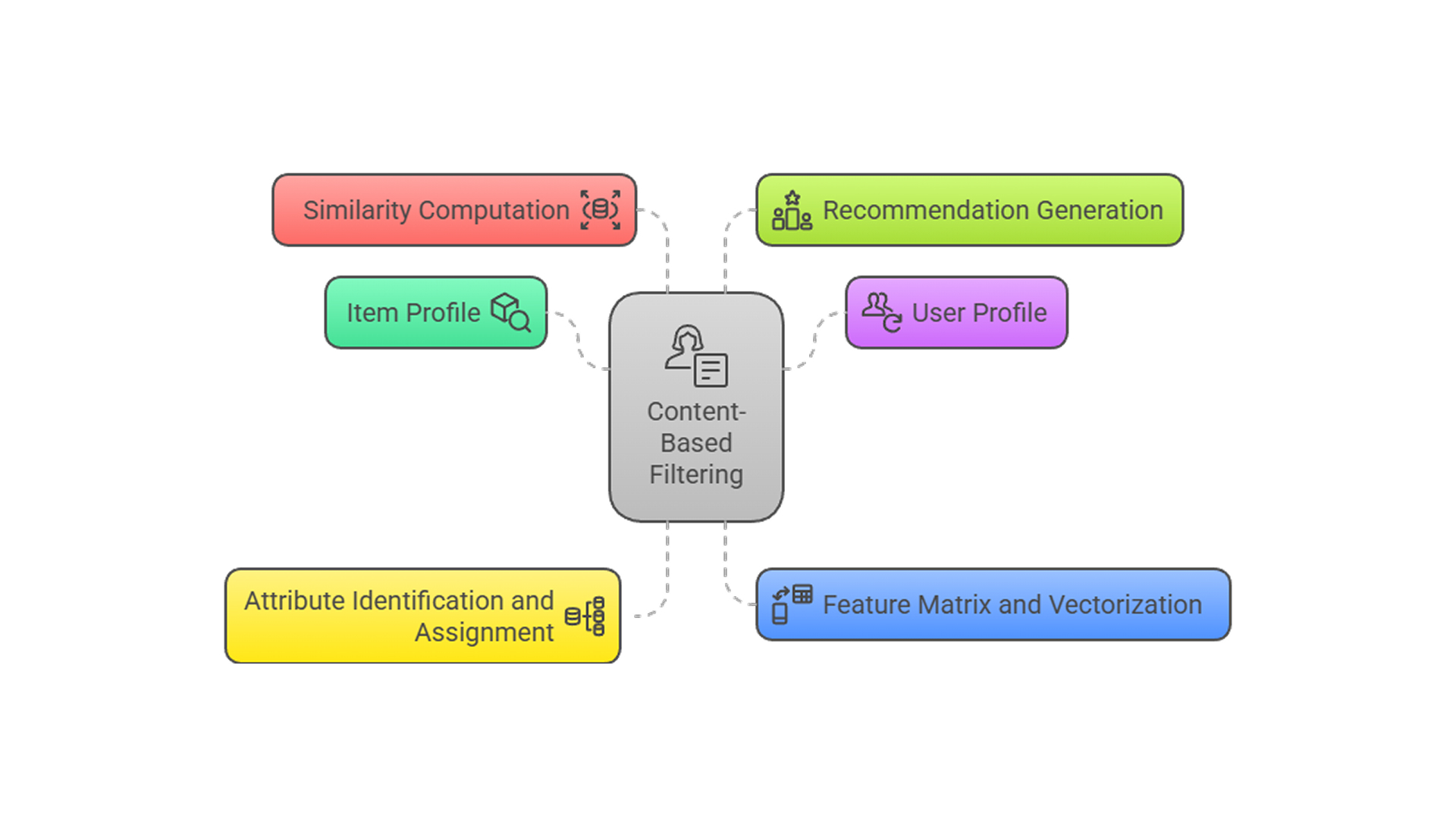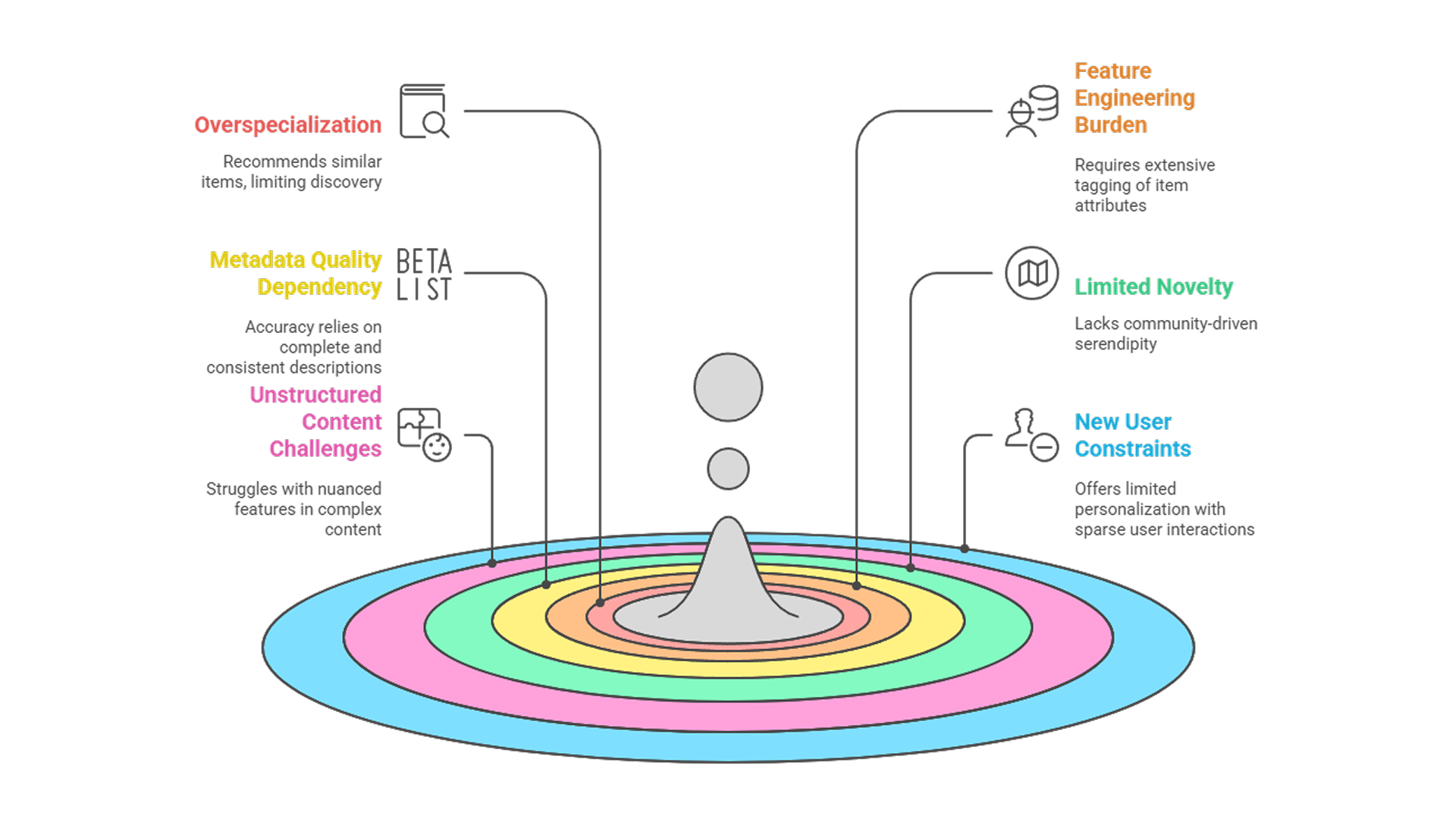What is Content Based Filtering?

Team Thinkstack
June 26, 2025
Table of Contents
Content-based filtering is a recommender approach that personalizes suggestions by modeling both items and users in the same feature space. Each item is represented by its intrinsic attributes, structured metadata (keywords, genres, product specifications), and unstructured descriptions converted into numerical vectors via text-vectorization techniques (e.g., count vectors, TF-IDF) or learned embeddings.
Systems employing content-based filtering assemble a user profile by aggregating that individual’s weighted interactions (purchases, ratings, clicks) along the same feature dimensions. Recommendations are generated by computing similarity scores, most commonly cosine similarity or dot product, between the user vector and each item vector, ranking items that most closely align with the user’s demonstrated preferences.
This method operates entirely on content characteristics and a single user’s history, without referencing other users’ behaviors. This independence enables immediate suggestions for newly added items once their attributes are defined and affords clear interpretability of each recommendation.
Role in Recommender Systems (vs. Collaborative & Hybrid)
Content-based filtering operates exclusively on item attributes and a single user’s history, enabling immediate recommendation of new or niche items once metadata is defined and offering transparent, attribute-driven suggestions.
Collaborative filtering, by contrast, leverages patterns across many users to introduce serendipity and diversity but requires substantial interaction data and often obscures the rationale behind recommendations. Content-based filtering trades some of that serendipity for precision and transparency, ensuring that each recommendation aligns tightly with the user’s established tastes.
Hybrid systems fuse these complementary strengths. Common hybrid strategies include:
- Sequential fallback begins with content-based recommendations and gradually incorporates collaborative scores as the user’s interaction history becomes sufficiently rich.
- Score blending computes both content-based and collaborative rankings, then weights and sums them to produce a final list.
- Feature augmentation enriches content profiles with collaborative-derived factors (e.g., popularity signals) or embeds content vectors into collaborative models.
This layered approach ensures rapid, attribute-driven recommendations alongside evolving diversity from community trends.
Core Components of Content-Based Filtering

Item Profile
An item profile encodes each product’s defining characteristics as a feature vector. Structured metadata and unstructured descriptions are transformed into numerical representations via text-vectorization or learned embeddings. This vector captures the presence, frequency, or weight of each attribute, forming the basis for later similarity computations.
User Profile
The user profile aggregates an individual’s weighted interactions, purchases, ratings, clicks, and searches into a parallel feature vector. Each attribute’s weight reflects its prominence across past behaviors.
Attribute Identification and Assignment
The attribute identification process catalogs each item’s intrinsic features, keywords, numerical specifications, and categorical labels into a unified feature space. Each feature’s consistent tagging and extraction method, whether through manual metadata annotation or automated pipelines (NLP for text, computer vision for images), ensures balanced representation and prevents skew in similarity calculations.
Feature Matrix and Vectorization
Once attributes are defined, items and users populate a feature matrix where rows represent entities and columns correspond to attributes. Binary, frequency, or normalized values fill the cells. Vectorization abstracts this matrix into high-dimensional vectors for each item and user. These embeddings reside in a shared vector space, enabling straightforward mathematical comparison.
Similarity Computation
Similarity metrics quantify proximity in the vector space.
- Cosine Similarity evaluates angular distance, favoring direction over magnitude in high-dimensional contexts.
- Euclidean Distance calculates the straight-line distance between two points in the vector space, emphasizing the actual magnitude of their differences.
- Dot Product combines angle and magnitude, useful when vector lengths carry semantic weight (e.g., popularity). Selection and weighting of metrics directly influence recommendation sensitivity and must align with the domain’s feature characteristics.
Recommendation Generation
With similarity scores computed between the user vector and all item vectors, the system ranks candidates in descending order of affinity. In item-based filtering, similarity to a specific browsed item predicts its related suggestions. Alternatively, a user-specific classifier or regression model trains on past interactions, treating item attributes as inputs and user behaviors as targets to forecast future preferences. The highest-scoring items form the final recommendation list.
Advantages and Limitations of Content-Based Filtering

Advantages
- Deep Personalization
Matches item features directly to an individual’s history, yielding unique recommendations tailored to each user’s demonstrated tastes. - Transparent Explanations
Every suggestion can be justified by specific attributes (e.g., genre overlap, shared keywords), fostering user trust and clarity. - Cold-Start Resilience
Recommends new items immediately based on metadata alone and provides initial suggestions for new users from minimal input. - Independence and Privacy
Operates without relying on other users’ data, preserving privacy and performing well in niche or low-traffic domains. - Scalability & Sparsity Robustness
Less affected by sparse interaction matrices; adding a new user or item requires only its feature vector, not a wealth of historical data. - Resistance to Manipulation
Recommendations are based on intrinsic item characteristics rather than user ratings, reducing vulnerability to shilling and review attacks.
Limitations

- Overspecialization
May repeatedly surface items too similar to past interactions, narrowing discovery and limiting diverse or serendipitous suggestions. - Feature Engineering Burden
Requires comprehensive, consistent tagging of every item attribute, often a labor-intensive, expert-driven process. - Metadata Quality Dependency
Recommendation accuracy degrades sharply if item descriptions are incomplete, inconsistent, or poorly structured. - Limited Novelty & Network Effects
Lacks the community-driven serendipity of collaborative methods and cannot leverage trends or popularity signals without hybridization. - Challenges with Unstructured Content
Struggles to capture nuanced features in images, audio, or complex text without advanced extraction. - New User Constraints
While better than collaborative filtering for cold starts, it still offers limited personalization when user interactions remain very sparse.
Conclusion
Content-based filtering occupies a core position in modern recommender systems by modeling items and users within a unified feature space, enabling immediate, interpretable personalization even for brand-new or niche content, without relying on community data. It underpins tailored experiences across e-commerce, media streaming, music platforms, social feeds, online learning, and health apps, where rich metadata drives precision. When integrated into hybrid architectures alongside collaborative methods, it balances focused relevance with necessary diversity, making it an indispensable component for scalable, trustworthy recommendations.
Also Read
What is Embedding Space?
Content-based filtering relies on embedding spaces to represent users and items as dense vectors in a shared feature space, enabling accurate similarity-based recommendations.
What is Semantic Understanding?
To go beyond basic keyword matching, content-based systems increasingly depend on semantic understanding to interpret item descriptions and user intent.
What is Automated Machine Learning?
Building and fine-tuning user/item profiles can be complex. Automated machine learning (AutoML) simplifies this by optimizing recommendation models with minimal manual effort.